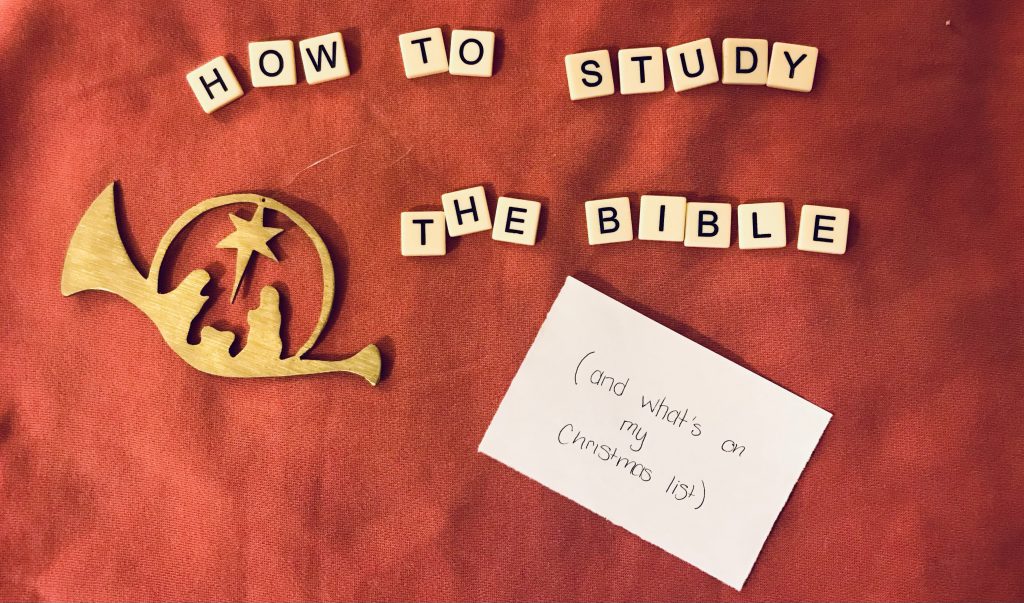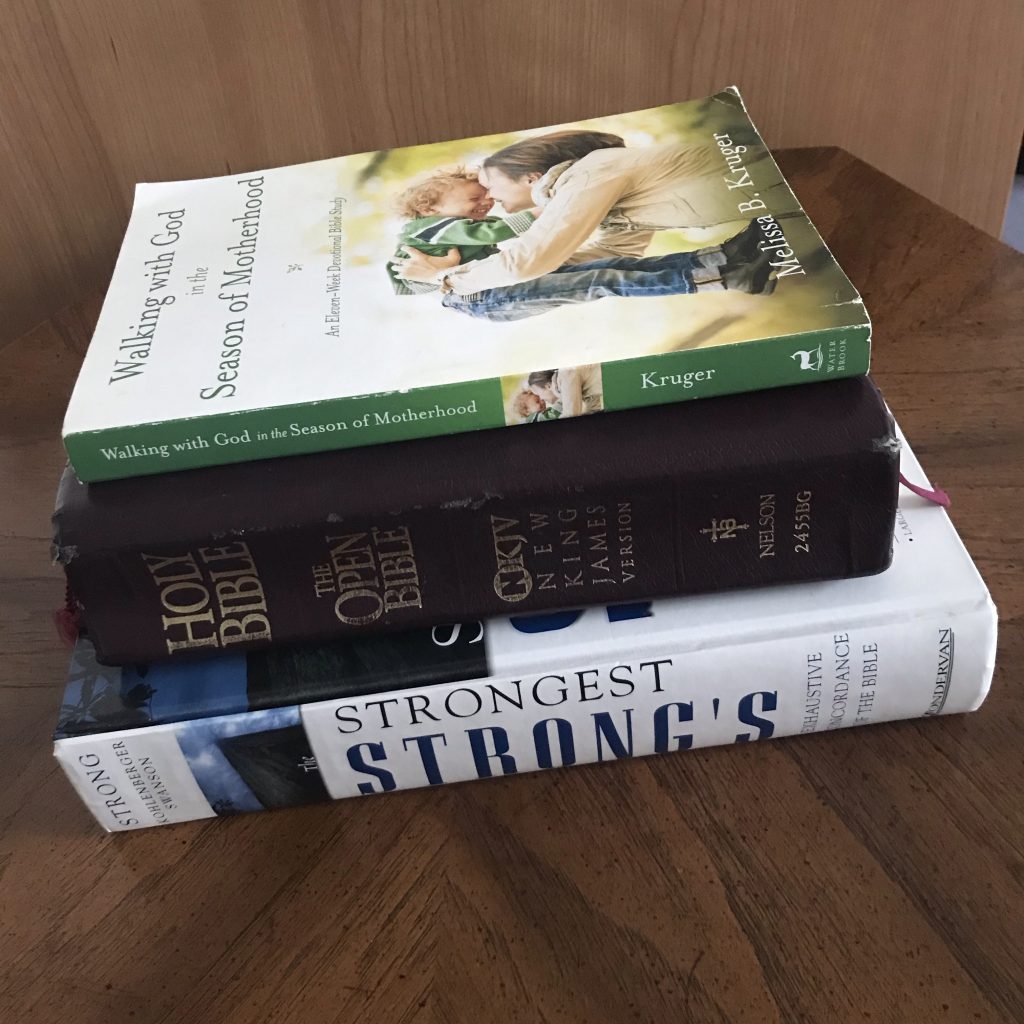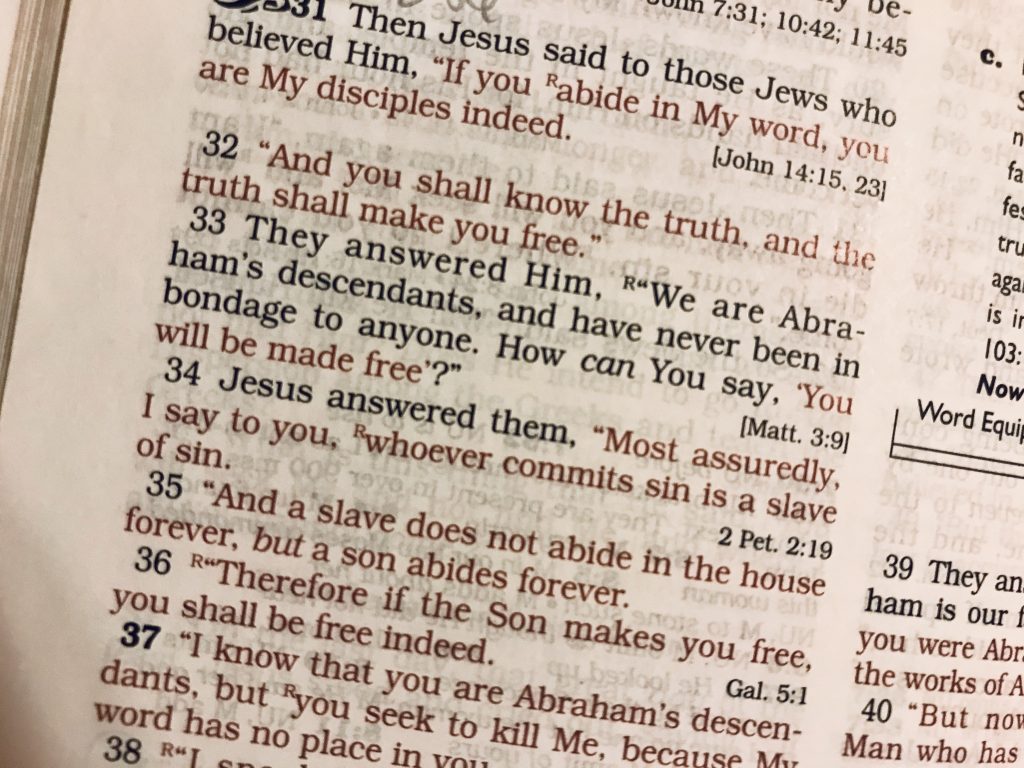Dear Friend,
This week I am sharing with you some Bible study basics (and what books and resources are on my Christmas list). I used to feel a bit in awe when the pastor would dive into the Hebrew root word in a passage or have the perfect quote to connect ideas. I thought he must be really well read (he was) and I could never do that (not exactly).
Learning just a bit about how to study my Bible has helped me grow in knowledge of and love for God. I wanted to share with you some tips on how to read and study your Bible. These are accessible to tips from a working mom with two small kids who also blogs on the side, so there’s nothing here that is super complicated or difficult. They barely scratch the surface of resources available to you. Feel free to comment below with additional ideas, resources, or questions.
Read Systematically
Read it like you WANT to understand. This means reading in a systematic way. Don’t run away just yet! I’m not telling you to buy a seminary-worthy copy of Systematic Theology (although the more you study, the more you may want to grab a copy). What I’m telling you is that you should read with a plan in mind.
Would you pick up a novel and read chapter 7, then chapter 2, then chapter 25 and expect it to make sense? While you don’t have to read the Bible cover to cover for it to make sense, you should read with a plan. If you are a new believer, it might make sense to start in the Gospel of John (New Testament, fourth book), but read it start to finish. Whatever book you read, read start to finish. There are different types of books in the Bible, but a significant portion are narrative with a beginning, middle, and end. They all point to Jesus, but the directions make more sense if you read them in order.
Some people read through a book one to two chapters each day, finding that this is a good amount to digest. Others add a Psalm or Proverb on top of that reading. Some use a scheduled calendar created to read the Bible in a certain timeframe, such as one year. This is totally doable, but I prefer to process smaller “chunks” of information. That said, certain books like Ruth and Esther can easily be read in one sitting, but benefit from deeper study.
Resources:
How to Read the Bible Book by Book
The Gospel Coalition 2 year Bible Reading Plan

Read Consistently
Consistency works with you towards two goals: building knowledge and building habits.
Have you ever started a project, gotten busy, put it away, and come back months later to discover that you barely remember what you were doing or how to do it? Have you ever opened a notebook of work from high school to discover that what you once knew is now completely foreign? When you do something consistently, including learning, you use each new act as a stepping stone on the last.
Reading you Bible daily allows you to cement your basis of knowledge. Chapters and books frequently refer back to past events, people, and promises. Sometimes books are almost duplicative in telling of the same events but from different perspectives. Each time you read, you refresh what you have studied and prepare for what you will study. Allowing large gaps of time to pass between readings forces you to reorient yourself and can make you miss rich details.
As we approach the new year, we will be bombarded with talk of resolutions and habit building. There are lots of great statistics out there about how many days it take to build or break habits, but the simplest explanation I know is a song from my childhood that I now sing to my kids:
Swinging is fun! Oh, Swinging is fun!
Swinging is fun for everyone!
The more you swing, the better you swing,
So keep on swinging, Swingity, swing!
Redundancy not only builds habits; it builds skill and confidence. The more you read, the better you read.
Context
The word of God is supreme and stands alone: this is my warning not to let context overshadow the actual Word of God. That said, context can give great depth and richness to scripture. There are two types of context to consider: Micro (details) and Macro (big picture).
Micro-context
Micro-context mean looking at historical details that would have been common knowledge to a reader when the scripture was written, but may be lost on the modern reader. Here’s an example I learned from SheSpeaks, a conference for Women Communicators hosted by Proverbs 31 Ministries: Acts 9-10 mentions that Peter stays with Simon the Tanner during his missionary journey. Random fact to be included, right? On second glance you might connect that a tanner is probably not the wealthiest and most popular, demonstrating Peter’s humility. But still, it doesn’t just say that Peter stayed with a believer that wasn’t wealthy. It identifies him as the tanner. Why?
In the days of Peter, tanners were not just lowly, they were stinky. Seriously. Tanners not only worked with dead animals, meaning that they would be considered unclean under Old Testament laws and unable to enter the temple; but they also commonly used animal urine to tan leather. Their stench was so common that a tanner’s wife could demand a divorce if she would not stand the smell of him.
A little bit of extra detail can add a lot to our understanding.
Macro-context
All scripture point to Jesus. Charles Spurgeon famously said “The motto of all true servants of God must be, ‘We preach Christ; and him crucified.’ A sermon without Christ in it is like a loaf of bread without any flour in it. No Christ in your sermon, sir? Then go home, and never preach again until you have something worth preaching.” As we read, we must examine how the passage points to Christ, otherwise we are merely studying history.

Exegesis
Don’t run away or skim this part! It’s good stuff!
Exegesis is the word-by-word study of Scripture. Words matter. Anyone who has studied a foreign language can tell you that sometimes English muddles things. Also important: the Bible was not originally written in English (not even King James English). It was originally written in Hebrew and Greek, depending on the passage. Here’s another example I learned from SheSpeaks. Here are two verses from Ephesians that both used the English word forgiveness:
1:7-8a In him we have redemption through his blood, the forgiveness of sins, in accordance with the riches of God’s grace that he lavished on us.
4:32 Be kind and compassionate to one another, forgiving each other, just as in Christ God forgave you.
In the first verse, the word forgiveness comes from the Greek word ἄφεσιν (aphesin). It means to pardon and has a legal connotation. The second verse uses a different Greek word: χαριζόμενοι (charizomenoi). It means to show favor and has a connotation of grace. Re-reading those passages with this knowledge give a richer reading that mushing the same English word together.
So how do you do this and find this? I use a free website: www.biblehub.com to search for a verse. Then I select Strong’s to go line by line. You can also click on each word to see other places scripture uses the same word. You can accomplish the same thing using a hard copy of Strong’s Concordance (available at most used book stores), but the process will be a bit more labor intensive.
Cross Reference
When I want to dig into a passage of scripture, I pull out my “big” bible. I purchased on my own at the age of 14. I chose it because it had extensive footnotes and cross references. Choose a Bible that does some of the work of scripture association for you. The more you read and become familiar, the more the passages will connect in your own mind, but cross references in your Bible are a great way to start making those connections. I use The Open Bible, but there are many many good options. Go to a real bookstore and flip through several.

Commentary
If you have found a new interpretation of scripture that no one before you has noticed, you are probably wrong and headed down a dangerous path. Another great resource on BibleHub is free access to dozens of commentaries. I always learn something new or see a connection I never noticed. You can pull up a single verse or group of verses and read from multiple whole-Bible commentaries from respected scholars before us. On of my personal favorites is Albert Barnes’ Notes on the Whole Bible.
My Christmas List
So what does all this have to do with what I want for Christmas? If you made it this far, I’m so humbled and grateful. Here are the top Bible Study Resources I’m asking for, and a few I love to give. (Note: these are NOT special affiliate links to earn me money – just pure suggestions I love)
- CSB Ancient Faith Study Bible I’m hearing great things about this one and have dropped more than one hint to my husband. This is supposed to help give historical context and commentary.
- The IVP Bible Background Commentary: Old Testament
The IVP Bible Background Commentary: New Testament, Second Edition
This two volume set is and affordable commentary set that is accessible to the Bible scholar that didn’t actually go to seminary. Most full-Bible commentaries are 10+ volumes and MUCH more expensive. - Gentle and Lowly: The Heart of Christ for Sinners and Sufferers by by Dane C. Ortlund *ON SALE at the time of Publishing*
2020 has been a hard year for many. Sometimes me need to look at ourselves less and fix our eyes on Christ. This book was released in April and I can’t wait to get my hands on it. - Commentary on the New Testament Use of the Old Testament Another affordable commentary but focused as its title says.
Gifts to Give:
For the new or not so new mom: Walking with God in the Season of Motherhood: An Eleven-Week Devotional Bible Study by Melissa B. Kruger is utterly fantastic. I can’t say enough good things about this. The scripture is included in the actual book so a busy mom can throw it in her bag or grab while nursing.
Kid’s Bibles:
The Jesus Storybook Bible I have learned so much reading this to my children and cried many good tears.
It’s All about Jesus Bible Storybook
The Big Picture Story Bible
Other books to read with your kids:
The Priest with the Dirty Clothes by RC Sproul – Great to talk to you kids about salvation.
The Wingfeather Saga by Andrew Petersen – My husband just finished reading this to our 5 year old (actually aimed for much older kids)
Happy reading!
Truthfully Yours,
DB
These are great suggestions, Dani!
A book I’ve been reading with helpful Bible study tips is “Women of the Word” by Jen Wilkin.
“The more you read, the better you read”—so true friend!! I have found that consistently (daily!) reading my Bible (with a plan) really increases my Bible “literacy”, meaning that I am able to see the big picture of the Bible so much better than when just occasionally doing random readings.
Also, if anyone is looking for a Bible reading plan—I love the Bible Reading Challenge. If you’re reading today, you’re not behind!
Excited to check out your other book recommendations—they look wonderful.
Thanks for the challenge to dig deeper, AND for the recommendations. Very interested in the Ortlund book.
And I don’t know the Jen Wilkin book, but I know she’s an amazing Bible teacher, Rachel T! Thanks for the heads-up.
I’ve been wishing all year I knew more about Biblical geography and how it connects to the narratives, and my very thoughtful husband gave me the Holman Bible Atlas (yesterday!), without me even having to drop any hints! I was SO excited!!
Hope all your Christmas wishes are fulfilled, Dani! 😉
I need alllll the reviews you have on your new Atlas!! (Include this in things I NEVER thought I’d say!)